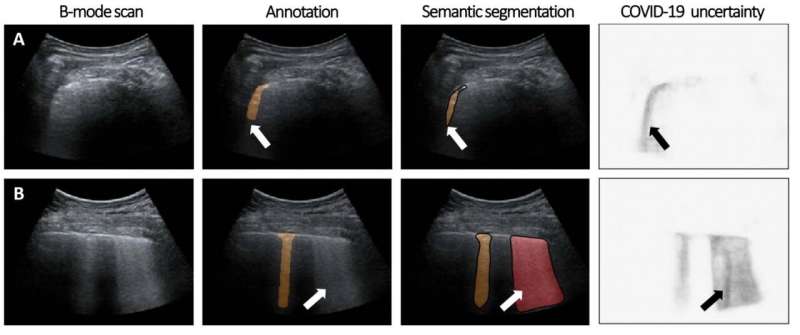Images (from acquisitions performed on patients) show case examples of ultrasound data where the added value provided by the algorithms is shown. Credit: University of Trento
The knowhow from the world's top experts in lung ultrasound were collected and organized in the software application. Their expertise is now quickly available to the medical community, in a functional way, free of charge, just a few clicks away. You just have to load the patient's scans and the software automatically compares them with data available, providing an accurate analysis that can help doctors make a diagnosis.
Artificial intelligence provides speed and accuracy, showing and grading abnormalities due to changes at the lung surface. This will support doctors in making faster and accurate diagnosis. In fact, lung ultrasound imaging (ultrasonography) reveals specific patterns that enable doctors to understand patients' conditions and choose the best possible treatment. Ultrasound waves, in other words, are used to 'take a picture' of the lungs and reveal any alteration.
"It is up to doctors to make a diagnosis. But these algorithms can be of great help. They keep on improving as we acquire, process and analyse more data" commented Libertario Demi, coordinator of the ICLUS project of the University of Trento. "These algorithms are used in hospitals and emergency rooms as we speak. We have started a collaboration with the Provincial Health Care Service, which is about to define a test phase in Trentino, and the Catharina Hospital in Eindhoven is already on board. The technology is being used in hospitals across Italy in Brescia, Valle del Serchio-Lucca, at Policlinico Universitario A. Gemelli and at Policlinico Universitario San Matteo.
The collaboration between medical doctors, physicists and computer engineers is crucial for its development. We are available to train health care workers and to further develop algorithms that can help them manage the pandemic. This solution is easily implemented: it is already available through a web application thanks to which doctors from all over the world can have algorithms examine their ultrasound data in real time. Doctors will be able to monitor the evolution of the disease at the patients' site as this technology is also available through wireless ultrasound systems."
The video (from acquisitions performed on patients) showcase examples of ultrasound data where the added value provided by the algorithms is shown. Credit: University of Trento
These diagnostic improvements could also make triage more efficient: "The algorithms give a response in a matter of seconds—explained Demi. You can examine five or more patients per hour with one machine. If you multiply this for all the available machines, the testing and monitoring capacity is significantly increased."
This solution also offers various advantages over alternative imaging technologies such as CT or MRI. It is cost-effective, can be installed on highly portable devices that can be utilized at patients' site, does not use ionizing radiation (as with CT), and can help minimizing the risk of contamination since it strongly reduces patients' mobility.
More information: Subhankar Roy et al, Deep learning for classification and localization of COVID-19 markers in point-of-care lung ultrasound, IEEE Transactions on Medical Imaging (2020). DOI: 10.1109/TMI.2020.2994459
Provided by Università di Trento






















